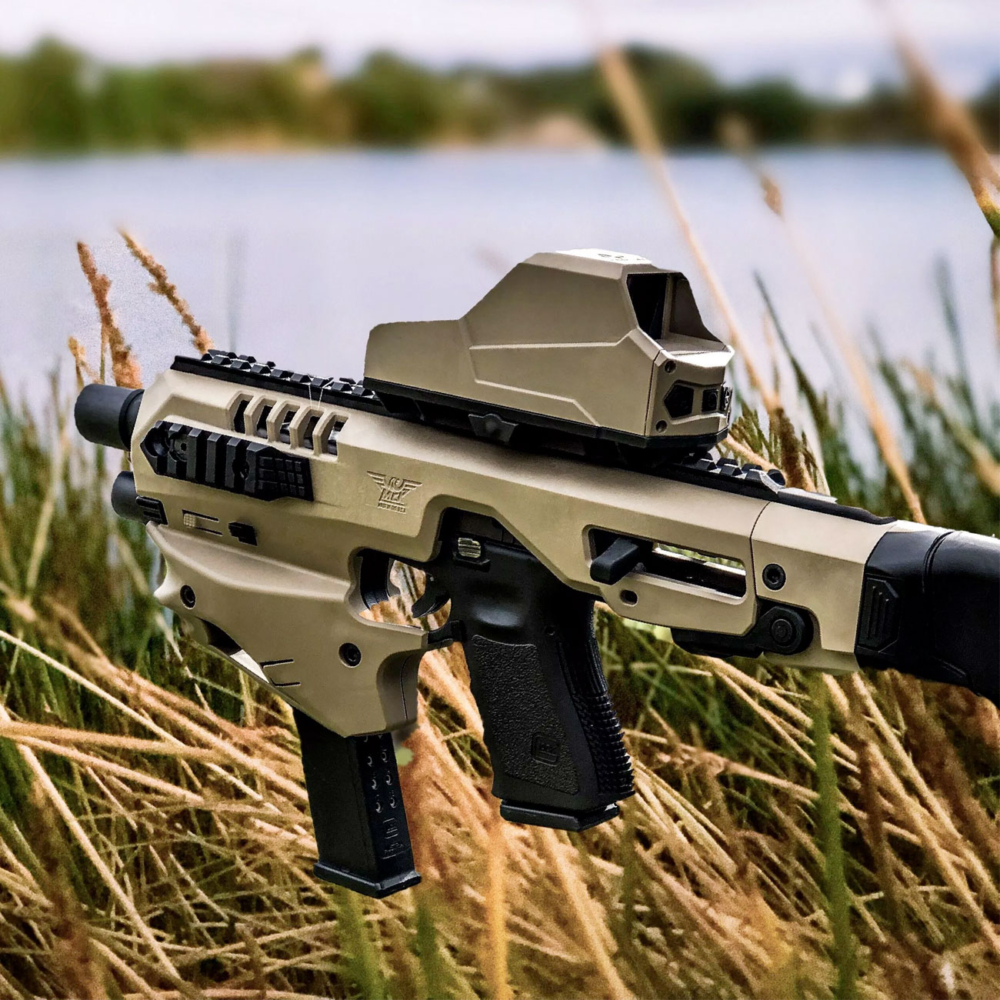By: Friedrich Seiltgen
Some readers may be familiar with the original CAA Roni, the futuristic-looking accessory that turned your Glock into the ultimate conversion kit. CAA has improved on their past generation models and created a new generation, 100% made in the USA kit they call the Micro Conversion Kit (MCK).
What’s the difference between the original and the MCK? Let’s take a look:
Some of the features of the MCK include:
• One model fits more than one handgun
• Charging handle stays inside of the conversion kit – making it one of the fastest pistol insertions and removal
• Exposed slide release
• Ergonomic front handgrip
• Spare magazine holder
• Comes with extended stabilizer brace
• Substantially reduced retail price – costing $100 less than the micro Roni
• 100% made in the USA
• Dramatically improves accuracy up to 200 yards
• Available in seven colors: Black, OD Green, Tan, White, Tungsten Gray, Pink, and USA Patriot Flag!
The new MCK is a lightweight, yet sturdy platform, that is currently available in four models:
• Glock 17/19/19x/22/23/31/32/45 (Gen 3, 4, 5)
• Glock 20/21
• Sig Sauer 320 (Full Size and Compact)
• S&W M&P 1.0 and 2.0 (Full Size and Compact)
Many shooters are a bit hesitant about buying weapons of this sort, as they are unsure about the legality of the stabilizing brace. Some think the brace turns the MCK into an NFA (National Firearms Act) short barreled rifle or machine gun. If they shoulder the brace, is it illegal?
This ruling from BATFE should clear things up:
ATF Clarifies Ruling on Pistol Stabilizing Braces
In a letter dated March 21, 2017, ATF reexamines its earlier position, which stated that shouldering a PSB-equipped firearm could constitute the making of an unregistered short-barreled rifle under the National Firearms Act (NFA). ATF now states:
“With respect to stabilizing braces, ATF has concluded that attaching the brace to a handgun as a forearm brace does not ‘make’ a short-barreled firearm because … it is not intended to be and cannot comfortably be fired from the shoulder.” The letter continues: “Therefore, an NFA firearm has not necessarily been made when the device is not re-configured for use as a shoulder stock — even if the attached firearm happens to be fired from the shoulder.”
The following passage from the letter acknowledges the confusion surrounding the January 2015 “Open Letter on the Redesign of ‘Stabilizing Braces’” and clarifies that ATF does not consider shouldering a PSB-equipped firearm, in and of itself, to render it an SBR.
“To the extent the January 2015 Open Letter implied or has been construed to hold that incidental, sporadic, or situational ‘use’ of an arm-brace (in its original approved configuration) equipped firearm from a firing position at or near the shoulder was sufficient to constitute a ‘redesign,’ such interpretations are incorrect and not consistent with ATF’s interpretation of the statute or the manner in which it has historically been enforced.”
If using a Glock 9mm, the shooter can have two of the 33-round Glock magazines with the weapon. One in the magazine well, and one up front as a forward grip. CAA has done its homework, and the Generation 2 MCK is an outstanding piece of engineering. I would not be surprised to see many law enforcement agencies use the MCK combined with their Glock 22 service weapons!
Another great feature of the MCK is that it is not a “firearm” by itself. The MCK can be purchased online or at your local gun shop, without any paperwork. There are gun ranges out there that have MCK equipped pistols for rent. Try one out and see for yourself!
That’s all for now folks, and as always, let’s be careful out there!
Friedrich Seiltgen is a retired Master Police Officer with 20 years of service with the Orlando Police Department. He is currently an Officer with the Starke, Florida Police Department. He conducts training in Lone Wolf Terrorism, Firearms, First Aid, Active Shooter Response, and Law Enforcement Vehicle Operations in Florida. His writing has appeared in The Counter Terrorist Magazine, Homeland Security Today and The Journal of Counterterrorism & Homeland Security International. Contact him at [email protected].
Photo credit: Caagearup.com

